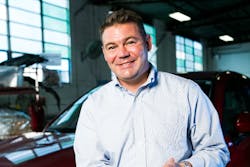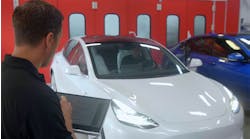The property was perfect:
As the home of a former Chevrolet dealership, it had a huge parking lot, an already existing body shop with a large footprint, tons of natural light and a well-kept lobby.
It was also located on a busy street in the small town of Crestwood, Mo., population 11,000, lined with businesses and tons of foot traffic.
What’s more, the price was right and Scott Schaefer was all but ready to sign the lease agreement to open his fifth location of Schaefer Autobody Centers, a small, familyowned MSO at the time.
“It was just an opportunity that came along at the right time with the right people,” he says.
It was nearly perfect, except for one problem: The rear property line was shared with residential homes. And those neighbors? To put it lightly, they were not happy about the possibility of a body shop moving in.
Before he knew it, Schaefer was at the center of a protest helmed by town residents and city council members that nearly resulted in losing the property and ostracizing the residents he was trying to turn into potential customers.
THE BACKSTORY
Schaefer Autobody began as a mechanical repair and body shop founded by Schaefer’s father, Steve, who was a mechanic by trade and purchased a preexisting Corvette repair shop. Over the years, the business dropped the mechanical work and slowly began adding locations throughout central Missouri. Although Schaefer now operates 10 locations (some of which are aluminum certified and hold numerous OEM certifications), at the time Schaefer was looking to add the Crestwood location, the business was up to four.
Schaefer Autobody has grown with a keen eye for numbers and continuous improvement: The operation subscribes to the Theory of Constraints management philosophy, which, in part, means the team aims to identify the limitations within the business that get in the way of efficiency; religiously tracks CSI scores and KPIs; and has made it a priority to build an efficient, productive shop culture.
So when it came time to expand to a fifth location in 2007, the search was thorough and strategic.
“The [Crestwood] location filled in a gap between two of our locations where we felt like there would be a large customer base that was being underserved at that time,” he says.
THE PROBLEM
The problems with that new location began when Schaefer tried to apply for the conditional use permit needed to operate a shop in the area. Although the Chevrolet dealership had already operated a body shop out of the same space for years, Crestwood residents thought the property should be turned into a community park.
“It’s a nice thought but it’s someone’s private property. You can’t exactly force them to do that,” says Schaefer. “For whatever reason, a few people stirred the pot, got a bunch of residents to start showing up to city council meetings and before you know it, there was a big local protest about us coming into the area. It was pretty crazy.”
Residents in the area created and signed a petition opposing the move and outlined their concerns. Chief among those was that the body shop was hazardous and would discharge chemicals into the air. Because the shop would work on roughly 35 percent more cars per month than the Chevrolet dealership’s body shop, residents argued that the fumes and odors would increase significantly. They also argued that the appearance of the shop and having damaged vehicles sit outside would lower property values in the area.
“From their perspective, they were most concerned about paint fumes and the isocyanates,” Schaefer says. “What they were afraid of was, back when we were using much lower-quality paint products years ago, like lacquer-based paint, there were a lot more fumes. A lot of people that were thinking that the paint shop was going to cause these fumes had memories of maybe smelling a body shop years ago. They didn’t know that the products had advanced so much that you really don’t smell it anyway.”
The city council meetings were becoming larger and more contentious. Although he knew that an option was always to fight it with a lawsuit or have the permit grandfathered from the dealership, Schaefer didn’t want to have to go that way and instead wanted to win over the neighborhood.
“We wanted to be a good neighbor,” he says.
THE SOLUTION
Schaefer started by agreeing to switch to waterborne paint, which would lower the amount of volatile organic compounds (VOCs) from entering the air. He then got together with his paint company, Sherwin-Williams, which provided resources regarding measuring the fumes and chemicals that were being exhausted from the paint booth. He also had a scientist and a civil engineer make drawings to help make sense of what waterborne paint and new booth technology would produce versus the existing paint booth.
“The difference between the two was huge,” he says. “It wasn’t just the filtration of the booth or the paint product itself, it was also how the booth was exhausting the fumes. It was basically exhausting it higher up in the air and giving the fumes more room to travel before they got anywhere close to hitting the residents.”
In addition to presenting that information to the city, Schaefer also volunteered to make a number of other changes after taking over the property:
He purchased a new downdraft, controlled airflow, waterborne paint booth and worked with the manufacturer, Global Finishing Solutions, to design a paint and prep area that not only had higher production capabilities, but was also more fuel and energy efficient, featured stronger contamination control and had shorter bake cycles. The paint booth is also located more than 100 feet farther away from the residential property line than the existing booth, which was located 120 feet away.
Schaefer installed a new exhaust system and customized the exhaust tower of the booth so that the tower was tall enough and the booth had enough strength to push the fumes high enough in the air so it wouldn’t settle in the neighbor’s property.
Any hazardous materials, such as paint thinners, were stored in a closed room to further reduce potential odors.
He refreshed the facade and main entrance to the building, as well as updated the customer waiting area to make it more inviting and aesthetically pleasing. Schaefer also built a fence that all vehicles would park behind so they wouldn’t be visible to area residents, and made sure that any parking lot lights weren’t on and beaming into the neighbor’s property late at night.
Schaefer went to all neighbors located within a couple hundred feet of his other four locations and asked if they had experienced any paint fumes, odors or anything unpleasant.
“I just wanted honest answers,” says Schaefer. “They pretty much all agreed that they hadn’t. I was able to get them to sign off on a small petition saying they hadn’t experienced any problems. That went a long way. Not only did it provide good information for the city council, but it also strengthened our community relations at our other three locations.”
Just like with the other locations, Schaefer and his staff started to become involved in the local community. They did so by donating vehicles through Recycled Rides, sponsoring local teams, joining the Rotary Club and the Chamber of Commerce, and becoming involved in local charities.
“The community involvement is so valuable,” he says. “It’s about building a brand and reputation. When you think that a customer only has an accident every 7–10 years, the chances are it’s not the ad that plays on the radio or TV that’s going to bring them in, they’re going to ask their friends and family who they know of or who they have experience with. We want to be the name that they say.”
THE AFTERMATH
Believe it or not, the Crestwood Board of Aldermen still denied Schaefer the conditional use permit by a 6-2 vote. Schaefer and the Chevrolet dealership ended up suing the city in early 2007 and the dealership eventually grandfathered the permit and allowed Schaefer to open under the dealership name. Included in the arrangement was a deal with the city that if Schaefer was able to prove they were good neighbors for two years, the permit would switch over and they could operate under the Schaefer Autobody name.
Thanks to the numerous changes made, Schaefer Autobody exceeded those expectations and was not only granted the permit in 2009, but was also awarded the “Community Improvement Award” from the area Chamber of Commerce in 2010.
The shop also won the Better Business Bureau Torch Award and Schaefer now serves on the board of directors for the St. Louis chapter.
“It all ended well,” he says. “They recognized our dedication for rehabbing the building and keeping everything looking really nice.”
THE TAKEAWAY
Although Schaefer made numerous changes and compromises when opening the Crestwood location, he says that the lessons learned have been invaluable to opening the additional five locations since then. Some of the other shops are now waterborne and have upgraded their paint booths to feature newer technology. They tell you location, location, location. But location doesn’t necessarily mean a great corner spot or a major route. I’ve had very profitable locations that are on a back street, a side street. That can be a gold mine. You want the best location you can in a market where there’s a need. There’s beautiful locations but if there’s no need for the business, you’re not going to be successful.
When it comes to challenges that pop up, in the past, I’ve paid too much money for certain businesses because I want to be in that market or there was something else that I liked about it. But I’ve also walked away from many of them. If you go into it understanding, here’s what I expect to make out of this facility and here’s my budget for the next couple of years, then it comes down to math. Does it make sense to spend the money on buying the shop, spend this money on upgrading the facility, spend this money on advertising? Is my return big enough? It’s however much return you want on your investment and how much risk you’re willing to take.
I would also recommend always checking with either your real estate agent or your zoning department on the codes for your city or county. Find out what type of zoning is required for your business. I see a lot of people wasting a lot of time looking at a site and trying to move forward, then come to find out it’s not zoned correctly. It’s very hard in most areas to increase the zoning to heavier use than what it is.
EXPERT ADVICE
Expanding a business and purchasing another shop can be a big endeavor that often comes with unexpected challenges and obstacles, like Schaefer experienced. When it comes to that process, there may be no one more experienced than Dave Mitchell. Mitchell grew Master Collision Repair into an eight-location, $17-million MSO before selling it to The Boyd Group. He then went on to work for Gerber and completed 29 acquisitions before deciding to open his own brand again, Car Guys Collision Repair, which grew to five locations in two years.



